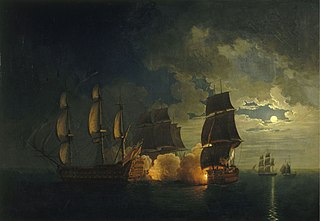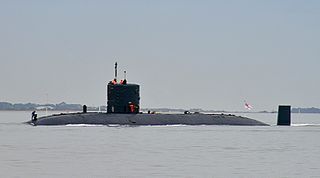Five ships of the British Royal Navy have been named HMS Torbay, after Torbay on the southwest English coast.

The Royal Navy (RN) is the United Kingdom's naval warfare force. Although warships were used by the English kings from the early medieval period, the first major maritime engagements were fought in the Hundred Years War against the Kingdom of France. The modern Royal Navy traces its origins to the early 16th century; the oldest of the UK's armed services, it is known as the Senior Service.

Torbay is a borough in Devon, England, administered by the unitary authority of Torbay Council. It consists of 62.87 square kilometres (24.27 sq mi) of land, spanning the towns of Torquay, Paignton and Brixham, located around an east-facing natural harbour on the English Channel. A popular tourist destination with a tight conurbation of resort towns, Torbay's sandy beaches, mild climate and recreational and leisure attractions have given rise to the nickname of the English Riviera.
- HMS Torbay (1693), an 80-gun second rate launched in 1693, rebuilt in 1719 and broken up in 1749.
- HMS Torbay was previously HMS Neptune, a 90-gun second rate launched in 1683, renamed Torbay in 1750 and sold in 1785.
- HMS Torbay (1919), an S-class destroyer launched in 1919. She was transferred to the Royal Canadian Navy in 1928 and renamed HMCS Champlain. She was sold in 1937.
- HMS Torbay (N79), a T-class submarine launched in 1940 and sold in 1945.
- HMS Torbay (S90), a Trafalgar-class nuclear submarine launched 1985 and decommissioned in 2017.
HMS Torbay was an 80-gun third rate ship of the line of the Royal Navy, launched at Deptford Dockyard on 16 December 1693. In 1707, she served as flagship of Rear-Admiral of the Blue Sir John Norris and belonged to Admiral Sir Cloudesley Shovell's fleet. She saw action during the unsuccessful Battle of Toulon and was present during the great naval disaster off the Isles of Scilly when Shovell and four of his ships were lost, claiming the lives of nearly 2,000 sailors. Torbay suffered little to no damage and finally managed to reach Portsmouth.

HMS Neptune was a 90-gun second-rate ship of the line of the Royal Navy. She was built under the 1677 "Thirty Great Ships" Programme and launched in 1683 at Deptford Dockyard.

The S class was a class of 67 destroyers ordered for the Royal Navy in 1917. They saw active service in the last months of the First World War and in the Russian and Irish Civil Wars during the early 1920s. Most were relegated to the reserve by the mid-1920s and subsequently scrapped under the terms of the London Naval Treaty. Eleven survivors saw much action during the Second World War.
| This article includes a list of ships with the same or similar names. If an internal link for a specific ship led you here, you may wish to change the link to point directly to the intended ship article, if one exists. |
